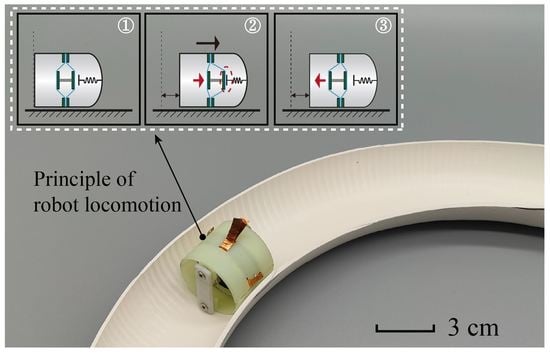A Dielectric Elastomer Actuator-Driven Vibro-Impact Crawling Robot
Abstract
:1. Introduction
2. DEA Design and Characterization
2.1. DEA Design Overview
2.2. DCDEA Fabrication and Experimental Setup
- A 100 µm silicone film (ELASTOSIL 2030, Wacker Chemie AG) was bonded to the acrylic support ring frame (20 mm inner diameter) using double-sided adhesive, and an 8 mm outer diameter acrylic center disk was bonded to the middle of the silicone film. The 20 mm ID was determined following the previous cone DEA studies [47,49], as a cone DEA with a smaller ID down to 1s mm becomes challenging in terms of fabrication.
- Custom-made carbon grease electrodes were applied evenly by a hand brush on both sides of the dielectric elastomer film.
- Two identical circular DE units were connected with nylon rods, while the outer frame was connected with shorter nylon rods such that the out-of-plane deformation of each film in the initial state was 2.5 mm. Note that the initial out-of-plane deformation of 2.5 mm results in a deformation-to-radius ratio of 0.25, which falls within the optimal ratio ranges reported in previous studies [39,46].
2.3. Analysis of DCDEA Dynamic Test Results
3. Robot Design and Characterization
3.1. Overview of Robot Design
3.2. Experimental Setup
3.3. Performance Characterization
3.3.1. Effects of Actuation Voltage
3.3.2. Effects of Constraint Gap (D)
3.3.3. Effects of Load Mass (M)
3.4. Robot Demonstrations
3.5. Results Discussion
4. Conclusions
- An actuation system composed of an impact constraint and a DCDEA produces complex nonlinear phenomena. A smaller constraint gap leads to stronger distortions in the frequency response curve of the DCDEA by causing a substantial increase in its resonant frequency.
- In comparing the performance of the robot with and without vibro-impacts, we showed by experiments that the vibro-impact has a decisive effect on the peak velocity of the robot, confirming the effectiveness of the design.
- The designed robot can realize bidirectional locomotion (both forward and backward) by a simple adjustment of the determinant parameters (i.e., actuation frequency and constraint gap). The robot achieved a forward velocity of up to 21.4 mm/s (0.71 BL/s) and a backward velocity of 16.9 mm/s. The robot showed good load capability, moving a load of 9.5 g (equivalent to its own body weight) at a velocity of 1.8 mm/s.
Author Contributions
Funding
Conflicts of Interest
References
- Tang, Z.; Lu, J.; Wang, Z.; Chen, W.; Feng, H. Design of a new air pressure perception multi-cavity pneumatic-driven earthworm-like soft robot. Auton. Robot. 2019, 44, 267–279. [Google Scholar] [CrossRef]
- Khan, M.B.; Chuthong, T.; Danh Do, C.; Thor, M.; Billeschou, P.; Larsen, J.C.; Manoonpong, P. Icrawl: An inchworm-inspired crawling robot. IEEE Access 2020, 8, 200655–200668. [Google Scholar] [CrossRef]
- Kim, T.-H.; Bao, C.; Chen, Z.; Kim, W.S. 3D printed leech-inspired origami dry electrodes for electrophysiology sensing robots. Npj Flex. Electron. 2022, 6, 5. [Google Scholar] [CrossRef]
- Li, D.; Niu, D.; Ye, G.; Lei, B.; Han, J.; Jiang, W.; Luo, F.; Chen, J.; Liu, H.; Lu, B. Crawling–jumping synergic bioinspired robots harnessing electroactive bistable actuators by adjusting mechanical responses and forces. Appl. Mater. Today 2021, 24, 101091. [Google Scholar] [CrossRef]
- Ahn, C.; Liang, X.; Cai, S. Bioinspired design of light-powered crawling, squeezing, and jumping untethered soft robot. Adv. Mater. Technol. 2019, 4, 1900185. [Google Scholar] [CrossRef]
- Wang, N.; Chen, B.; Ge, X.; Zhang, X.; Wang, W. Modular crawling robots using soft pneumatic actuators. Front. Mech. Eng. 2020, 16, 163–175. [Google Scholar] [CrossRef]
- Yang, Y.; Tse, Y.A.; Zhang, Y.; Kan, Z.; Wang, M.Y.; IEEE. A low-cost inchworm-inspired soft robot driven by supercoiled polymer artificial muscle. In Proceedings of the 2nd IEEE International Conference on Soft Robotics (RoboSoft), Seoul, Korea, 14–18 April 2019; pp. 161–166. [Google Scholar]
- Satyanarayana Pillai, S.; Sreedharan, P. Design, manufacturing and testing of re-configurable crawling modular robot inspired from origami. IOP Conf. Ser. Mater. Sci. Eng. 2019, 577, 012142. [Google Scholar] [CrossRef]
- Qin, L.; Liang, X.; Huang, H.; Chui, C.K.; Yeow, R.C.; Zhu, J. A versatile soft crawling robot with rapid locomotion. Soft Robot 2019, 6, 455–467. [Google Scholar] [CrossRef]
- Moreira, F.; Abundis, A.; Aguirre, M.; Castillo, J.; Bhounsule, P.A. An inchworm-inspired robot based on modular body, electronics and passive friction pads performing the two-anchor crawl gait. J. Bionic Eng. 2018, 15, 820–826. [Google Scholar] [CrossRef]
- Shi, Z.; Pan, J.; Tian, J.; Huang, H.; Jiang, Y.; Zeng, S. An inchworm-inspired crawling robot. J. Bionic Eng. 2019, 16, 582–592. [Google Scholar] [CrossRef]
- Chang, M.H.; Chae, S.H.; Yoo, H.J.; Kim, S.-H.; Kim, W.; Cho, K.-J.; IEEE. Loco-sheet: Morphing inchworm robot across rough-terrain. In Proceedings of the 2nd IEEE International Conference on Soft Robotics (RoboSoft), Seoul, Korea, 14–18 April 2019; pp. 808–813. [Google Scholar]
- Zhou, W.; Gravish, N. Rapid two-anchor crawling from a milliscale prismatic-push-pull (3p) robot. Bioinspiration Biomim. 2020, 15, 065001. [Google Scholar] [CrossRef] [PubMed]
- Muralidharan, M.; Brolin, A.; Mithun, R.; Patil, R.; Palani, I.A. Investigations on bending characteristics of soft mesh structure using shape memory alloy spring towards bio-inspired robotic applications. Iran. J. Sci. Technol. Trans. Mech. Eng. 2020, 45, 927–937. [Google Scholar] [CrossRef]
- Duduta, M.; Berlinger, F.; Nagpal, R.; Clarke, D.R.; Wood, R.J.; Temel, F.Z. Tunable multi-modal locomotion in soft dielectric elastomer robots. IEEE Robot. Autom. Lett. 2020, 5, 3868–3875. [Google Scholar] [CrossRef]
- Verma, M.S.; Ainla, A.; Yang, D.; Harburg, D.; Whitesides, G.M. A soft tube-climbing robot. Soft Robot 2018, 5, 133–137. [Google Scholar] [CrossRef] [PubMed]
- Wang, W.; Yan, G.; Wang, Z.; Jiang, P.; Meng, Y.; Chen, F.; Xue, R. A novel expanding mechanism of gastrointestinal microrobot: Design, analysis and optimization. Micromachines 2019, 10, 24. [Google Scholar] [CrossRef] [Green Version]
- Han, Y.; Marvi, H.; Sitti, M.; IEEE. Fiberbot: A miniature crawling robot using a directional fibrillar pad. In Proceedings of the IEEE International Conference on Robotics and Automation (ICRA), Seattle, WA, USA, 26–30 May 2015; pp. 3122–3127. [Google Scholar]
- Song, X.; Qiu, X.; Huang, X.; Xu, M.; Zhang, L. Light-driven awn-footed soft robots. Macromol. Mater. Eng. 2022, 307, 2101003. [Google Scholar] [CrossRef]
- Cao, C.; Diteesawat, R.S.; Rossiter, J.; Conn, A.T.; IEEE. A reconfigurable crawling robot driven by electroactive artificial muscle. In Proceedings of the 2nd IEEE International Conference on Soft Robotics (RoboSoft), Seoul, Korea, 14–18 April 2019; pp. 840–845. [Google Scholar]
- Zhan, X.; Xu, J.; Fang, H. A vibration-driven planar locomotion robot—Shell. Robotica 2018, 36, 1402–1420. [Google Scholar] [CrossRef]
- Lu, Q.; Mahtab, B.; Zhao, F.; Song, K.-Y.; Feng, Y. Bioinspiration to robot locomotion implementing 3d printed foxtail grass. In Proceedings of the 2021 IEEE International Conference on Robotics and Biomimetics (ROBIO), Sanya, China, 6–9 December 2021; pp. 69–73. [Google Scholar]
- Sheng, X.; Xu, H.; Zhang, N.; Ding, N.; Zhu, X.; Gu, G. Multi-material 3d printing of caterpillar-inspired soft crawling robots with the pneumatically bellow-type body and anisotropic friction feet. Sens. Actuators A Phys. 2020, 316, 112398. [Google Scholar] [CrossRef]
- Wu, C.; Zhang, Z.; Zheng, W. A twisted and coiled polymer artificial muscles driven soft crawling robot based on enhanced antagonistic configuration. Machines 2022, 10, 142. [Google Scholar] [CrossRef]
- Liu, Y.; Wiercigroch, M.; Pavlovskaia, E.; Yu, H. Modelling of a vibro-impact capsule system. Int. J. Mech. Sci. 2013, 66, 2–11. [Google Scholar] [CrossRef]
- Gu, X.D.; Deng, Z.C. Dynamical analysis of vibro-impact capsule system with hertzian contact model and random perturbation excitations. Nonlinear Dyn. 2018, 92, 1781–1789. [Google Scholar] [CrossRef]
- Barenboim, M.; Degani, A.; IEEE. Steerable burrowing robot: Design, modeling and experiments. In Proceedings of the IEEE International Conference on Robotics and Automation (ICRA), virtual, 31 May–15 June 2020; pp. 829–835. [Google Scholar]
- Liu, Y.; Páez Chávez, J.; Zhang, J.; Tian, J.; Guo, B.; Prasad, S. The vibro-impact capsule system in millimetre scale: Numerical optimisation and experimental verification. Meccanica 2020, 55, 1885–1902. [Google Scholar] [CrossRef]
- Duong, T.-H.; Van, C.N.; Ho, K.-T.; La, N.-T.; Ngo, Q.-H.; Nguyen, K.-T.; Hoang, T.-D.; Chu, N.-H.; Nguyen, V.-D. Dynamic response of vibro-impact capsule moving on the inclined track and stochastic slope. Meccanica 2022. [Google Scholar] [CrossRef]
- Zhang, J.; Tian, J.; Zhu, D.; Liu, Y.; Prasad, S. Design and experimental investigation of a vibro-impact self-propelled capsule robot with orientation control. In Proceedings of the 2022 International Conference on Robotics and Automation (ICRA), Philadelphia, PA, USA, 23–27 May 2022; pp. 11381–11387. [Google Scholar]
- Wu, L.; Lu, K. A development study of a new bi-directional solenoid actuator for active locomotion capsule robots. Electronics 2020, 9, 736. [Google Scholar] [CrossRef]
- Li, J.; Liu, L.; Liu, Y.; Leng, J. Dielectric elastomer spring-roll bending actuators: Applications in soft robotics and design. Soft Robot 2019, 6, 69–81. [Google Scholar] [CrossRef] [PubMed]
- Yang, X.; Chang, L.; Perez-Arancibia, N.O. An 88-milligram insect-scale autonomous crawling robot driven by a catalytic artificial muscle. Sci. Robot. 2020, 5, eaba0015. [Google Scholar] [CrossRef]
- Chen, S.; Cao, Y.; Sarparast, M.; Yuan, H.; Dong, L.; Tan, X.; Cao, C. Soft crawling robots: Design, actuation, and locomotion. Adv. Mater. Technol. 2019, 5, 1900837. [Google Scholar] [CrossRef]
- Ma, C.; Xia, Y.; Lu, T. Large actuation in an electromechanical actuator using gel, elastomer, and oil. Int. J. Non-Linear Mech. 2020, 124, 103499. [Google Scholar] [CrossRef]
- Pelrine, R.; Kornbluh, R.; Pei, Q.B.; Joseph, J. High-speed electrically actuated elastomers with strain greater than 100%. Science 2000, 287, 836–839. [Google Scholar] [CrossRef]
- He, L.; Lou, J.; Du, J.; Wang, J. Finite bending of a dielectric elastomer actuator and pre-stretch effects. Int. J. Mech. Sci. 2017, 122, 120–128. [Google Scholar] [CrossRef]
- Henke, E.M.; Wilson, K.E.; Anderson, I.A. Modeling of dielectric elastomer oscillators for soft biomimetic applications. Bioinspir. Biomim. 2018, 13, 046009. [Google Scholar] [CrossRef] [PubMed] [Green Version]
- Cao, C.; Gao, X.; Conn, A.T. Towards efficient elastic actuation in bio-inspired robotics using dielectric elastomer artificial muscles. Smart Mater. Struct. 2019, 28, 095015. [Google Scholar] [CrossRef]
- Cao, C.; Chen, L.; Li, B.; Chen, G.; Nie, Z.; Wang, L.; Gao, X. Toward broad optimal output bandwidth dielectric elastomer actuators. Sci. China Technol. Sci. 2022, 65, 1137–1148. [Google Scholar] [CrossRef]
- Cao, C.; Gao, X.; Conn, A.T. A magnetically coupled dielectric elastomer pump for soft robotics. Adv. Mater. Technol. 2019, 4, 1900128. [Google Scholar] [CrossRef]
- Baumgartner, R.; Kogler, A.; Stadlbauer, J.M.; Foo, C.C.; Kaltseis, R.; Baumgartner, M.; Mao, G.; Keplinger, C.; Koh, S.J.A.; Arnold, N.; et al. A lesson from plants: High-speed soft robotic actuators. Adv. Sci. 2020, 7, 1903391. [Google Scholar]
- Chen, F.-Y.; Ren, Z.-X.; Lau, G.-K. Maximal strengths of dielectric elastomer fingers for a passive grip. Smart Mater. Struct. 2022, 31, 045014. [Google Scholar] [CrossRef]
- Xing, Z.; Zhang, J.; McCoul, D.; Cui, Y.; Sun, L.; Zhao, J. A super-lightweight and soft manipulator driven by dielectric elastomers. Soft Robot 2020, 7, 512–520. [Google Scholar] [CrossRef]
- Zhao, H.; Hussain, A.M.; Israr, A.; Vogt, D.M.; Duduta, M.; Clarke, D.R.; Wood, R.J. A wearable soft haptic communicator based on dielectric elastomer actuators. Soft Robot 2020, 7, 451–461. [Google Scholar] [CrossRef]
- Cao, C.; Conn, A.T. Performance optimization of a conical dielectric elastomer actuator. Actuators 2018, 7, 32. [Google Scholar] [CrossRef] [Green Version]
- Cao, C.; Chen, L.; Duan, W.; Hill, T.L.; Li, B.; Chen, G.; Li, H.; Li, Y.; Wang, L.; Gao, X. On the mechanical power output comparisons of cone dielectric elastomer actuators. IEEE/ASME Trans. Mechatron. 2021, 26, 3151–3162. [Google Scholar] [CrossRef]
- Moretti, G.; Rizzello, G.; Fontana, M.; Seelecke, S. High-frequency voltage-driven vibrations in dielectric elastomer membranes. Mech. Syst. Signal Process. 2022, 168, 108677. [Google Scholar] [CrossRef]
- Cao, C.; Gao, X.; Burgess, S.; Conn, A.T. Power optimization of a conical dielectric elastomer actuator for resonant robotic systems. Extrem. Mech. Lett. 2020, 35, 100619. [Google Scholar] [CrossRef]
- Farmer, C.W.; Medina, H. Improved model for conical dielectric elastomer actuators with fewer electrical connections. J. Mech. Robot. 2020, 12, 031016. [Google Scholar]
- Yusupov, A.; Liu, Y. Development of a self-propelled capsule robot for pipeline inspection. In Proceedings of the 22nd International Conference on Automation & Computing (ICAC), Colchester, UK, 7–8 September 2016; pp. 84–88. [Google Scholar]
- Nguyen, K.-T.; La, N.-T.; Ho, K.-T.; Ngo, Q.-H.; Chu, N.-H.; Nguyen, V.-D. The effect of friction on the vibro-impact locomotion system: Modeling and dynamic response. Meccanica 2021, 56, 2121–2137. [Google Scholar] [CrossRef]
- Zhang, J.; Liu, Y.; Zhu, D.; Prasad, S.; Liu, C. Simulation and experimental studies of a vibro-impact capsule system driven by an external magnetic field. Nonlinear Dyn. 2022, 109, 1501–1516. [Google Scholar] [CrossRef]
- Ji, X.; Liu, X.; Cacucciolo, V.; Imboden, M.; Civet, Y.; El Haitami, A.; Cantin, S.; Perriard, Y.; Shea, H. An autonomous untethered fast soft robotic insect driven by low-voltage dielectric elastomer actuators. Sci. Robot. 2019, 4, eaaz6451. [Google Scholar] [CrossRef] [PubMed]
- Chen, Y.; Zhao, H.; Mao, J.; Chirarattananon, P.; Helbling, E.F.; Hyun, N.P.; Clarke, D.R.; Wood, R.J. Controlled flight of a microrobot powered by soft artificial muscles. Nature 2019, 575, 324–329. [Google Scholar] [CrossRef]
- Tang, C.; Du, B.; Jiang, S.; Shao, Q.; Dong, X.; Liu, X.-J.; Zhao, H. A pipeline inspection robot for navigating tubular environments in the sub-centimeter scale. Sci. Robot. 2022, 7, eabm8597. [Google Scholar] [CrossRef]
- Asghar, Z.; Shah, R.A.; Ali, N. A computational approach to model gliding motion of an organism on a sticky slime layer over a solid substrate. Biomech. Model. Mechanobiol. 2022. [Google Scholar] [CrossRef]
- Shah, R.A.; Asghar, Z.; Ali, N. Mathematical modeling related to bacterial gliding mechanism at low reynolds number with ellis slime. Eur. Phys. J. Plus 2022, 137, 600. [Google Scholar] [CrossRef]
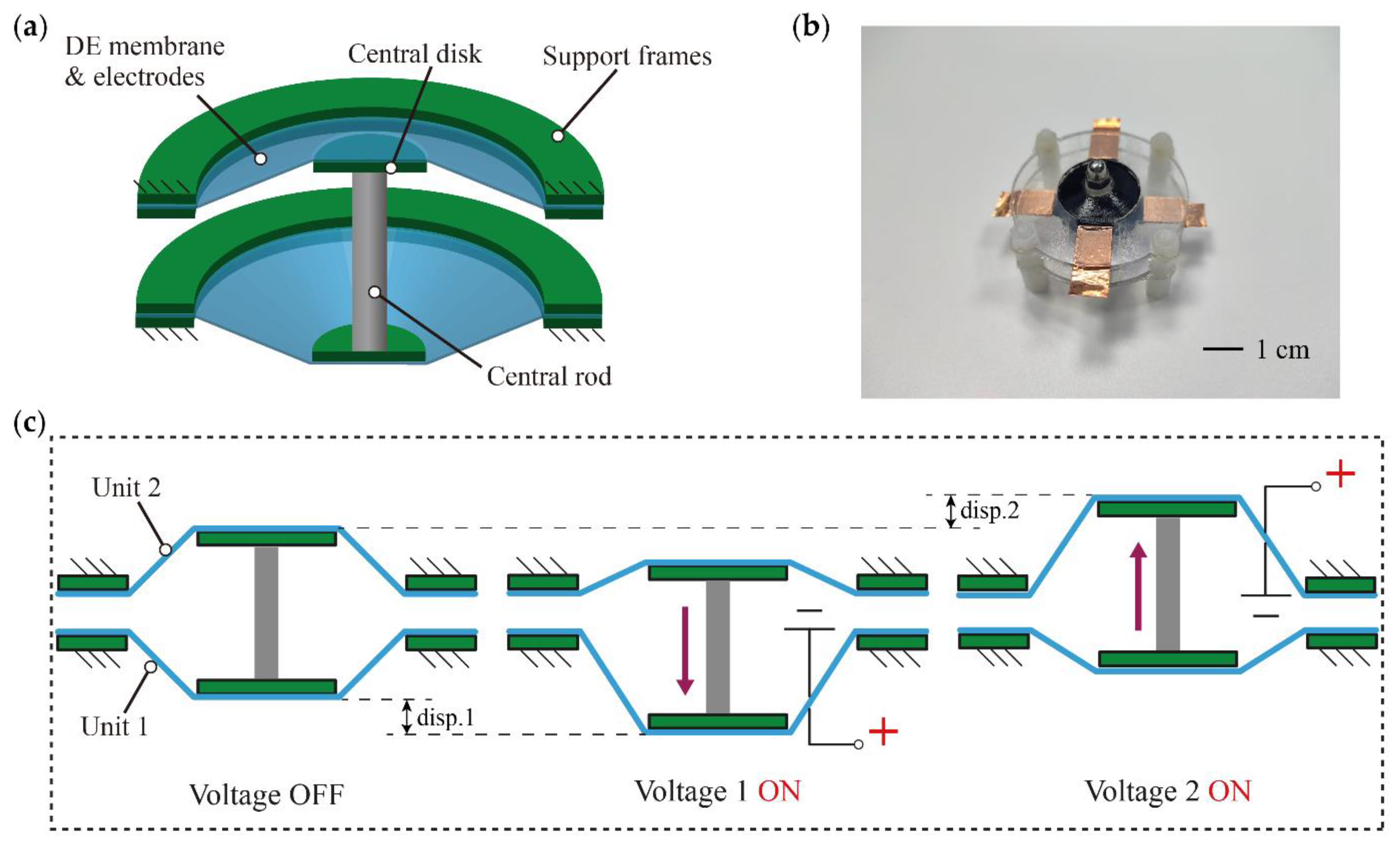
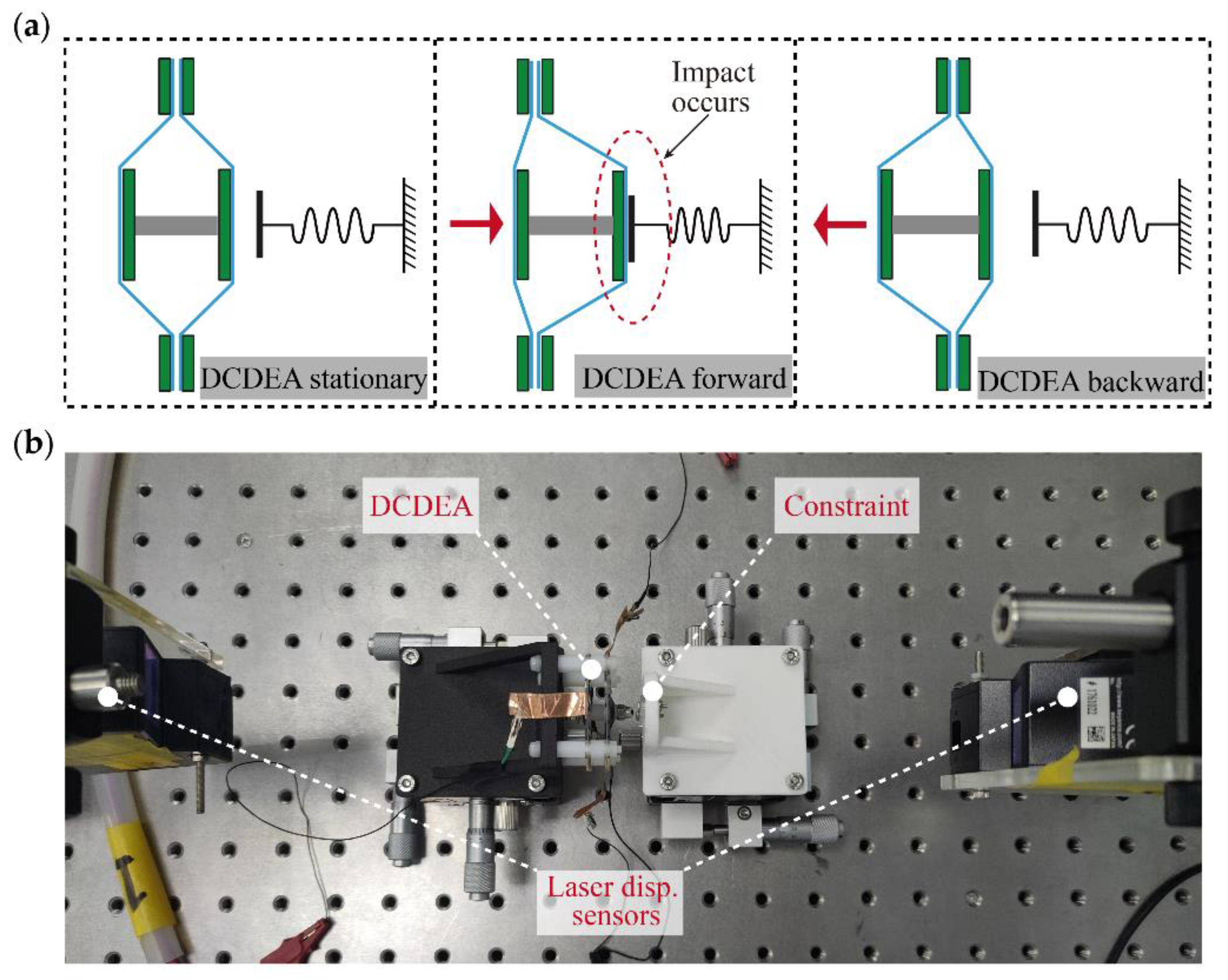
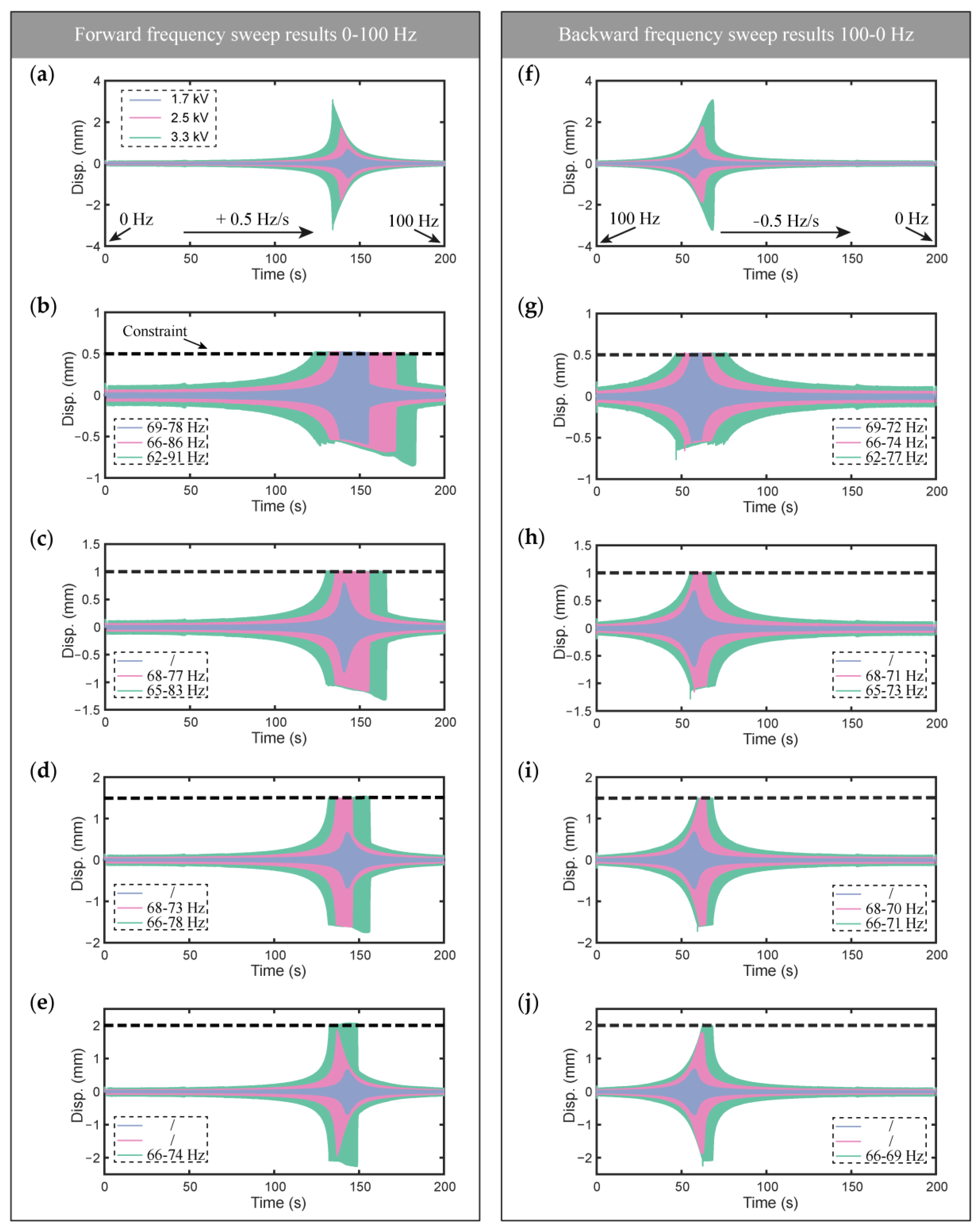



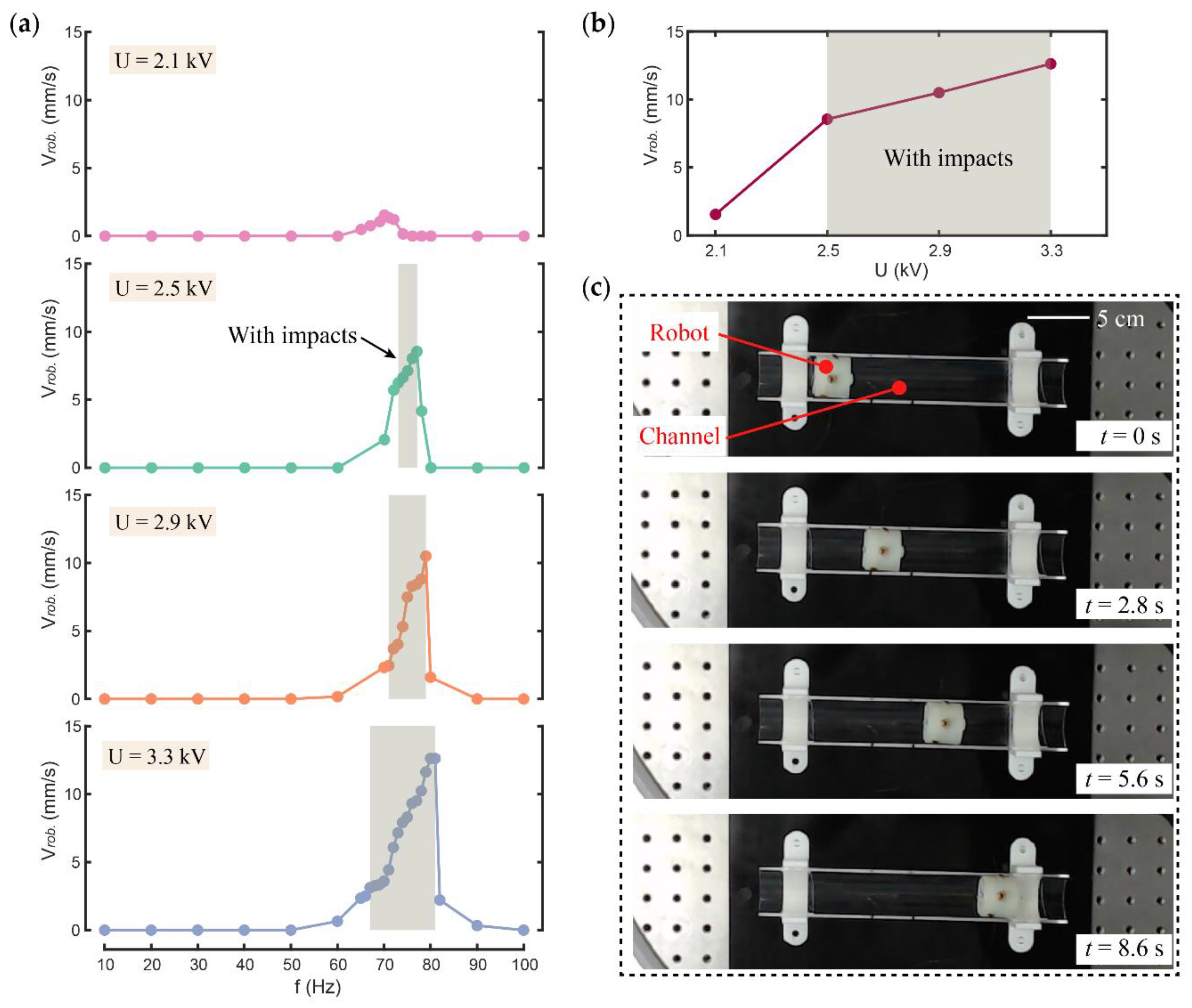




| Design Parameters | Values | Units |
|---|---|---|
| Length | 30 | mm |
| Outer diameter | 32 | mm |
| Total weight | 9.5 | 9.5 |
| DCDEA moving mass | 1.7 | g |
| DCDEA electrode diameter | 20 | mm |
| DCDEA out-of-plane deformation per unit | 2.5 | mm |
| DCDEA membrane thickness | 100 | µm |
| Impact gap | 0.6–1.6 | mm |
| Reference | Dimensions (mm) | Actuation Source | Weigh t(g) | Peak Velocity (BL/s) |
|---|---|---|---|---|
| [51] | OD 80 | Linear DC servomotor | 500 | ~0.1 |
| [28] | 26 × OD 11 | An internal magnet and an external coil | 3.47 | 0.55 |
| [52] | / | Electro-dynamical shaker | 2336 | / |
| [30] | 34 × OD 15 | Four internal coils and an internal magnet | 5.38 | 0.16 |
| [53] | 26 × OD 11 | An internal magnet and two external coils | 3.47 | 0.13 |
| Current work | 30 × OD 32 | DCDEA | 9.5 | 0.71 |
Publisher’s Note: MDPI stays neutral with regard to jurisdictional claims in published maps and institutional affiliations. |
© 2022 by the authors. Licensee MDPI, Basel, Switzerland. This article is an open access article distributed under the terms and conditions of the Creative Commons Attribution (CC BY) license (https://creativecommons.org/licenses/by/4.0/).
Share and Cite
Wu, C.; Yan, H.; Cai, A.; Cao, C. A Dielectric Elastomer Actuator-Driven Vibro-Impact Crawling Robot. Micromachines 2022, 13, 1660. https://doi.org/10.3390/mi13101660
Wu C, Yan H, Cai A, Cao C. A Dielectric Elastomer Actuator-Driven Vibro-Impact Crawling Robot. Micromachines. 2022; 13(10):1660. https://doi.org/10.3390/mi13101660
Chicago/Turabian StyleWu, Chuang, Huan Yan, Anjiang Cai, and Chongjing Cao. 2022. "A Dielectric Elastomer Actuator-Driven Vibro-Impact Crawling Robot" Micromachines 13, no. 10: 1660. https://doi.org/10.3390/mi13101660





